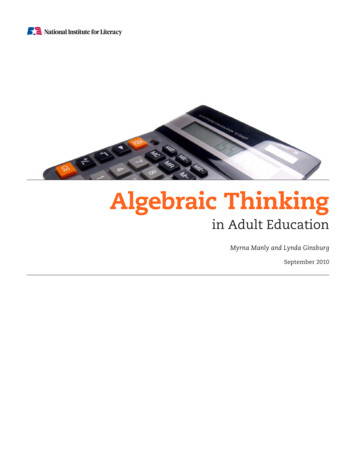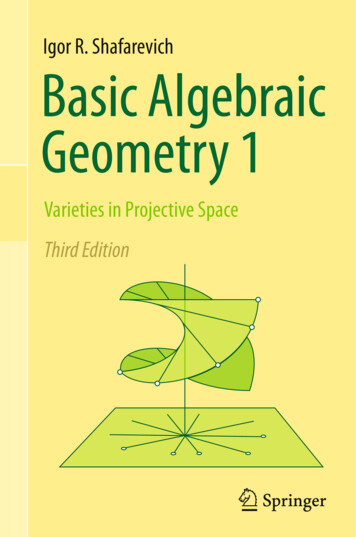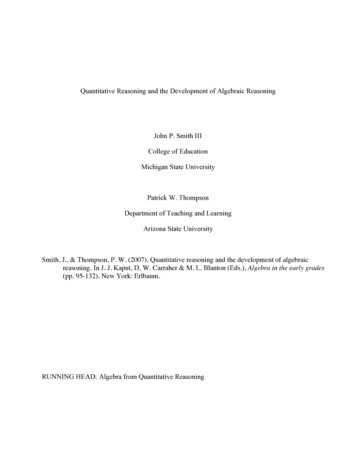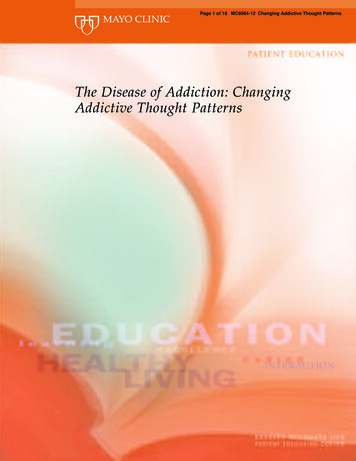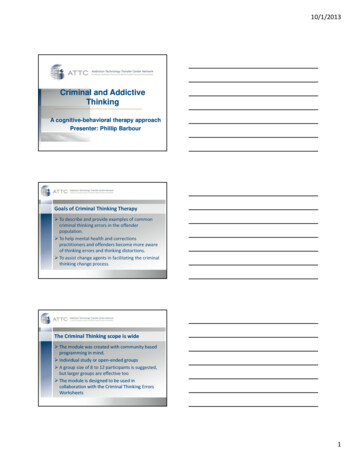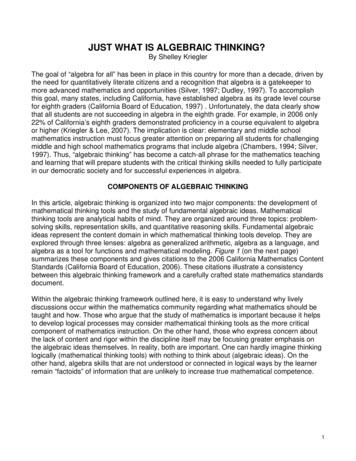
Transcription
JUST WHAT IS ALGEBRAIC THINKING?By Shelley KrieglerThe goal of “algebra for all” has been in place in this country for more than a decade, driven bythe need for quantitatively literate citizens and a recognition that algebra is a gatekeeper tomore advanced mathematics and opportunities (Silver, 1997; Dudley, 1997). To accomplishthis goal, many states, including California, have established algebra as its grade level coursefor eighth graders (California Board of Education, 1997) . Unfortunately, the data clearly showthat all students are not succeeding in algebra in the eighth grade. For example, in 2006 only22% of California’s eighth graders demonstrated proficiency in a course equivalent to algebraor higher (Kriegler & Lee, 2007). The implication is clear: elementary and middle schoolmathematics instruction must focus greater attention on preparing all students for challengingmiddle and high school mathematics programs that include algebra (Chambers, 1994; Silver,1997). Thus, “algebraic thinking” has become a catch-all phrase for the mathematics teachingand learning that will prepare students with the critical thinking skills needed to fully participatein our democratic society and for successful experiences in algebra.COMPONENTS OF ALGEBRAIC THINKINGIn this article, algebraic thinking is organized into two major components: the development ofmathematical thinking tools and the study of fundamental algebraic ideas. Mathematicalthinking tools are analytical habits of mind. They are organized around three topics: problemsolving skills, representation skills, and quantitative reasoning skills. Fundamental algebraicideas represent the content domain in which mathematical thinking tools develop. They areexplored through three lenses: algebra as generalized arithmetic, algebra as a language, andalgebra as a tool for functions and mathematical modeling. Figure 1 (on the next page)summarizes these components and gives citations to the 2006 California Mathematics ContentStandards (California Board of Education, 2006). These citations illustrate a consistencybetween this algebraic thinking framework and a carefully crafted state mathematics standardsdocument.Within the algebraic thinking framework outlined here, it is easy to understand why livelydiscussions occur within the mathematics community regarding what mathematics should betaught and how. Those who argue that the study of mathematics is important because it helpsto develop logical processes may consider mathematical thinking tools as the more criticalcomponent of mathematics instruction. On the other hand, those who express concern aboutthe lack of content and rigor within the discipline itself may be focusing greater emphasis onthe algebraic ideas themselves. In reality, both are important. One can hardly imagine thinkinglogically (mathematical thinking tools) with nothing to think about (algebraic ideas). On theother hand, algebra skills that are not understood or connected in logical ways by the learnerremain “factoids” of information that are unlikely to increase true mathematical competence.1
Mathematical Thinking ToolsFigure 1: Components of Algebraic Thinking(with illustrative citations from the 2006 Mathematics Framework for California PublicSchools, Kindergarten Through Grade Twelve)Mathematical Thinking ToolsFundamental Algebraic IdeasProblem solving skills Using problem solving strategies(Gr 7 MR 1.3, MR 2.0). Exploring multiple approaches/multiple solutions(Gr 7 MR 2.0, 2.5).Algebra as generalized arithmetic Conceptually based computational strategies (Gr7 NS 2.2). Ratio and proportion (Gr 6 NS 1.2, 1.3). Estimation (Gr 7 MR 2.7).Representation skills Displaying relationships visually, symbolically,numerically, verbally(Gr 7 MR 2.5). Translating among different representations(Gr 7 MR 2.3, 2.5). Interpreting information within representations(Gr 7 MR 2.5, 2.6).Algebra as the language of mathematics Meaning of variables and variable expressions(Gr 4 AF 1.1). Meaning of solutions (Gr 4 NS 1.4). Understanding and using properties of thenumber system (Gr 5 AF 1.3). Reading, writing, manipulating numbers andsymbols using algebraic conventions(Gr 6 AF 1.3). Using equivalent symbolic representations tomanipulate formulas, expressions, equations,inequalities (Gr 4 AF 2.1, 2.2; Gr 7 AF 1.3).Quantitative reasoning skills Analyzing problems to extract and quantifyessential features (Gr 7 MR 1.1). Inductive and deductive reasoning(Gr 7 MR 2.4).Algebra as a tool for functions and mathematicalmodeling Seeking, expressing, generalizing patterns andrules in real-world contexts (Gr 6 AF 3.2). Representing mathematical ideas usingequations, tables, graphs, or words(Gr 6 AF 1.0). Working with input/output patterns(Gr 4 AF 1.5). Developing coordinate graphing skills(Gr 5 AF 1.4).Mathematical thinking tools are organized here into three general categories: problem-solvingskills, representation skills, and reasoning skills. These thinking tools are essential in manysubject areas, including mathematics; and quantitatively literate citizens utilize them on aregular basis in the workplace and as part of daily living.Problem-solving requires having the mathematical tools to figure out what to do when onedoes not know what to do. Students who have a toolkit of problem-solving strategies (e.g.,guess and check, make a list, work backwards, use a model, solve a simpler problem, etc.) arebetter able to get started on a problem, attack the problem, and figure out what to do with it.Furthermore, since the real world does not include an answer key, exploring mathematicalproblems using multiple approaches or devising mathematical problems that have multiplesolutions gives students opportunities to develop good problem-solving skills and experiencethe utility of mathematics.2
The ability to make connections among multiple representations of mathematical informationgives students quantitative communication tools. Mathematical relationships can be displayedin many forms including visually (i.e. diagrams, pictures, or graphs), numerically (i.e. tables,lists, with computations), symbolically, and verbally 1 . Often a good mathematical explanationincludes several of these representations because each one contributes to the understandingof the ideas presented. The ability to create, interpret, and translate among representationsgives students powerful tools for mathematical thinking.Finally, quantitative reasoning is fundamental to success in mathematics, and algebraicthinking helps develop quantitative reasoning within an algebraic framework (Kieran andChalouh, 1993). Since applications of mathematics rarely require making calculations on“naked numbers,” analyzing problems to extract and quantify relevant information is anessential reasoning skill. Inductive reasoning involves examining particular cases, identifyingpatterns and relationships among those cases, and extending the patterns and relationships.Deductive reasoning involves drawing conclusions by examining a problem’s structure.Quantitatively literate citizens routinely utilize these types of reasoning on a regular basis.Fundamental Algebraic IdeasThe line between the study of informal algebraic ideas and formal algebra is often blurred, andthe algebra ideas identified here are intended to be studied in concrete or familiar contexts sothat students will develop a strong conceptual base for later abstract study of mathematics. Inthis framework, algebraic ideas are viewed in three ways: algebra as generalized arithmetic,algebra as a language, and algebra as a tool for functions and mathematical modeling.Algebra is sometimes referred to as generalized arithmetic; therefore, it is essential thatinstruction give students opportunities to make sense of general procedures performed onnumbers and quantities (Battista and Van Auken Borrow, 1998; Vance, 1998). According toBattista, thinking about numerical procedures should begin in the elementary grades andcontinue until students can eventually express and reflect on procedures using algebraicsymbol manipulation (1998). By routinely encouraging conceptual approaches when studyingarithmetic procedures, students will develop a network of mathematical structures to drawupon when they begin their study of formal algebra. Here are three examples: Elementary school children typically learn to multiply whole numbers using the “U.S.Standard Algorithm.” This procedure is efficient, but the algorithm easily obscures importantmathematical connections, such as the role of the distributive property in multiplication orhow area and multiplication are connected. These require attention as well. The “means-extremes” procedure for solving proportions provides middle school studentswith an easy-to-learn rule, but does little to help them understand the role of themultiplication property of equality in solving equations or develop sense-making notionsabout proportionality. These ideas are essential to the study of algebra, and attention totheir conceptual development will ease the transition to a more formal study of the subject.1Kriegler et al. (2007) use this approach extensively in an algebra readiness program called Introduction toAlgebra. It is called the “fourfold way.”3
The widely accepted distance from the earth to the sun is estimated at 93 million miles, butestablishing some referants for the meaning of the magnitude of 93,000,000 requiresmanipulation of ratios and rates and a well-developed generalized number sense.Algebra is a language (Usiskin, 1997). To comprehend this language, one must understandthe concept of a variable and variable expressions, and the meanings of solutions. It involvesappropriate use of the properties of the number system. It requires the ability to read, write,and manipulate both numbers and symbolic representations in formulas, expressions,equations, and inequalities. In short, being fluent in the language of algebra requiresunderstanding the meaning of its vocabulary (i.e. symbols and variables) and flexibility to useits grammar rules (i.e. mathematical properties and conventions). Historically, beginningalgebra courses have emphasized this view of algebra. Here are two examples: How to interpret symbols or numbers that are written next to each other can be problematicfor students. In our number system, the symbol “149” means “one hundred forty-nine.”However, in the language of algebra, the expression “14x” means “multiply fourteen by ‘x.’”Furthermore, x14 14x, but “14x” is the preferred expression because, by convention, wewrite the numeral or “coefficient” first. The variables used in algebra take on different meanings, depending on context. Forexample, in the equation 3 x 7, “x” is an unknown, and “4” is the solution to theequation. But in the statement A(x y) Ax Ay, the “x” is being used to generalize apattern.Finally, algebra can be viewed as a tool for functions and mathematical modeling. Through thislens, algebraic thinking shows students the real-life uses and relevance of algebra (Herbertand Brown, 1997). Seeking, expressing, and generalizing patterns and rules in real worldcontexts; representing mathematical ideas using equations, tables, and graphs; working withinput and output patterns; and developing coordinate graphing techniques are mathematicalactivities that build algebra-related skills. Functions and mathematical modeling representcontexts for the application of these algebraic ideas.EXAMPLES OF ALGEBRAIC THINKINGTwo problems and their solutions (see Figure 2) are used here to illustrate some of thedecribed components of algebraic thinking. “Smart Shopping” (Greenes and Findell, 1998) is aproblem that can lead to generalized thinking about arithmetic. “The Garden Problem”(Creative Publications, 1998) requires students to find an algebraic expression for a geometricfigure and exemplifies algebra as a language, and as a tool for functions and modeling.Furthermore, many mathematical thinking tools are evident within the student solutions. Theyuse diverse approaches and solution strategies, they communicate ideas in a variety of ways,and they use explanations to show evidence of analytical reasoning.Neither of these problems is likely to be difficult for people with well-developed algebra skills,and both of these problems can be solved without using much algebraic thinking. For example,most students initially answered the “Smart Shopping” problem by computing unit prices (see4
Figure 3 - Solution 1), and many students initially found the number of tiles required for agarden with a length of 12 units by drawing a picture and counting (see Figure 4 - Solution 6).However, challenging students to find solutions using more than one method created practiceopportunities for algebraic thinking. By sharing teacher and student methods in class, studentsbegan to adopt the mathematical thinking tools and algebra skills of others.Figure 2: Two Problems“Smart Shopping”Two shops sell chocolate chip cookies.A. Kelly wants to buy cookies. Which shop has the better buy?B. Explain your answer.“The Garden Problem”Gardens are framed with a single row of tiles as illustrated here.(A garden of length 3 requires 12 border tiles.)1A. How many border tiles are required for a garden of length 12?B. How many border tiles are required for a garden of length “n”?C. Show how to find the length of the garden if 152 tiles are used for the border.Mathematical Thinking Tools RevisitedMathematical thinking tools were used in a variety of ways when students solved theseproblems. Problem-solving approaches included making a table, looking for patterns, usingmodels and diagrams, and working backwards. Students represented solutions numerically,symbolically, graphically, and verbally. They extracted relevant numerical information from theproblems, and their explanations provided evidence of both inductive and deductive reasoning.For example, in Figure 4 - Solution 7, the student used specific cases in the table to predict anumerical pattern. In Figure 6 - Solution 16, the student used the structure of the problem tocreate an inverse function, and expressed it with symbols.5
Figure 3: Solution to “Smart Shopping” – Part A (Which is a better buy?)Solution 1: Uses multiplicative identity in secondSolution 4: Uses proportional thinking strategymethod (generalized arithmetic)(generalized arithmetic) and interprets input-outputpattern (function)Solution 5: Represents and interprets mathematical ideausing a coordinate graph (function)Solution 2: Uses conceptually based computationstrategy (generalized arithmetic)Solution 3: Uses proportional thinking strategy(generalized arithmetic) and interprets an inputoutput pattern (function)6
Figure 4: Solutions To “The Garden Problem” – Part AHow many border tiles are required for a garden of length 12?Solution 6: Begins to seek and express a pattern forSolution 8: Identifies general way to expressfinding perimeter tiles (functions/modeling)perimeter of garden (functions/modeling), usesassociative and commutative properties to compute(generalized arithmetic, language)Solution 7: Seeks pattern for number of tiles needed,represents relationship with input-output table(functions/modeling)Solution 9: Describes general pattern for findingperimeter tiles (functions/modeling), usesdistributive property to compute (generalizedarithmetic, language)7
More About Algebraic IdeasStudent solutions to “Smart Shopping” (Figure 3) illustrate several informal algebraic ideas.Use of the multiplicative identity to find equivalent fractions is evident in the second method ofSolution 1. Although it is unclear whether students used additive or multiplicative procedures,the potential for proportional reasoning is clearly demonstrated in the rate series (Solution 2)and in the tables (Solutions 3 and 4). Some students used function concepts to solve the“Smart Shopping” problem. In Solutions 3 and 4, students analyzed the inputs and outputs intheir tables to arrive at conclusions. In Solution 5, the student used a rate graph to solve theproblem.Student work from the three parts of the “The Garden Problem” also provide evidence of manyinformal algebraic ideas that are important in the development of algebraic thinking (seeFigures 4, 5, 6). In Part A, students used conceptual approaches to arithmetic, which helpedthem to understand the pattern within the problem. Part B required the use of a variable torepresent an algebraic expression. Students used deductive thinking in both Parts B and C tofind and apply functional relationships for the number of tiles in the geometric design.Figure 5: Solutions to “The Garden Problem” – Part BHow many border tiles are required for a garden of length “n”?Solution 10: Generalizes pattern with symbolic ruleSolution 12: Generalizes pattern with symbolic rule(functions/modeling), finds equivalent algebraic(functions/modeling), uses variable in expressionexpressions, uses standard notation (language)(language)Solution 11: Generalizes pattern with symbolic rule(functions/modeling), uses variable in expression(language)Solution 13: Generalizes pattern with symbolic rule(functions/modeling), uses variable in expression(language)8
Finding the answer to Part A (Figure 4) was not difficult for students; however, doing it in a waythat revealed something about the structure of the geometric design laid the groundwork for aformula or expression. In Solution 6, the student added the top and bottom of the border to thetiles on each side. This solution can lead to general expressions such as (n 2) (n 2) 1 1or 2(n 2) 2. The author of Solution 7 made a table and explained that each stage of thegarden design increased by 2. This approach helps to explain the need to multiply the gardenlength by 2 in a general expression such as 2n 6. Solutions 8 and 9 revealed interestingbreakdowns of the parts of the garden, and the computation procedures illustratedunderstanding of mathematical properties important to algebra. In Solution 8, the student usedboth the associative and commutative properties as she added the number of tiles above andbelow the garden to those on the sides. The student who wrote Solution 9 viewed the gardenplot as a solid rectangle and then subtracted the garden itself. The distributive property isimplied within her calculation: 3(14) 3(10 4) 3(10) 3(4).Figure 6: Solutions to “The Garden Problem” – Part CShow how to find the length of the garden if 152 tiles are used for the border.Solution 14: Given output, calculatesSolution 15: Informally describes an output-input relationshipinput (function)(function)Solution 16: Manipulates formulas (language), uses output-inputrelationship (function)Part B (Figure 5) required the use of a variable to express the number of tiles needed to borderthe garden. Student solutions reveal four equivalent expressions derived directly fromexamining patterns in the garden, and the solutions show that the students’ abilities to useestablished conventions for writing expressions are developing. For example, in Solution 10,the student showed that he understood that “n n” is equal to “n times 2," which can be writtenn2 or 2n. By his work, we see that he is learning that it is customary to write the numericalcoefficient first.9
Finding multiple expressions for the number of tiles in the border can lead to other algebraicthinking opportunities. For example, from Solutions 10 and 11, we see that2(n 3) 2 n 6. Verifying that the symbolic expressions are equivalent creates practice forsimplifying expressions and a context for discussion of mathematical properties. Substitutingvalues into the expressions to find the number of border tiles needed for specific cases helpsstudents to understand the meaning of solutions and practice using order of operations.Solutions to Part C (Figure 6) show students’ emerging abilities to find and use an inversefunction. In Solution 14, the student’s computational procedure demonstrates her ability toapply an inverse process for a specific case. In Solution 15, the student explained verbally howthe rule must be applied “backwards.” The author of Solution 16 was able to write both thefunction and inverse function symbolically.CONCLUSIONAs large percentages of students struggle to prepare for algebra, programs that supportstudent development of algebraic thinking are becoming increasingly visible in schools.California, for example, recognized the need to offer such programs, and included algebrareadiness standards in its 2007 Mathematics Framework for California Public Schools,Kindergarten Through Grade Twelve. Curricular materials such as Introduction to Algebra(Kriegler et al., 2007) have been developed to meet these standards.Algebra is recognized as a gateway to higher education and opportunities, and successfulparticipation in our democratic society and technology-driven world requires the abstractmathematical thinking inherent in it (Dudley, 1998; Riley, 1998). But for students to achieveaccess to and success in the formal study of algebra, they need to achieve fluency usingmathematical thinking tools and informal algebraic ideas. This research-based algebraicthinking framework can be used to critically examine goals, materials, and instructionstrategies that promote the development of mathematical thinking tools and fundamentalalgebraic ideas, and serve as a reminder of important elements in the development ofalgebraic thinking.10
BILBLIOGRAPHYBattista, M., & Van Auken Borrow, C. (1998, January). Using spreadsheets to promote algebraicthinking. Teaching Children Mathematics, V4, 470-478.California State Board of Education (1997). Mathematics framework for California public schools,kindergarten through grade twelve. Sacramento, CA: California Department of Education.California State Board of Education (2006). Mathematics framework for California public schools,kindergarten through grade twelve. Sacramento, CA: California Department of Education.Chambers, D. (1994, March). The right algebra for all. Educational Leadership, 51, 85.Dudley, U. (1998, March). Is mathematics necessary? Mathematics Education Dialogues, 1, 2, 4-6.Greenes, C., & Findell, C. (1998). Algebra puzzles and problems, grade 6. Mountain View, CA:Creative Publications.Herbert, K., & Brown, R. H. (1997, February). Patterns as tools for algebraic reasoning. TeachingChildren Mathematics, 3, 340-344.Kieran, C., & Chalouh, L. (1993). Prealgebra: the transition from arithmetic to algebra. In DouglasT. Owens (Ed.), Research ideas for the classroom: Middle grades mathematics (pp. 178192). Reston, VA: National Council of Teachers of Mathematics.Kriegler, S., & Lee, T. (2007). Using standardized test data as guidance for placement into 8thgrade algebra. Retrieved March 31. 2007, from Introduction to Algebra. Web site:www.introtoalg.org/downloads/Algebra 8th Grade Paper.pdfKriegler, S. et al. (2007) Introduction to algebra. Los Angeles, CA: Center for Mathematics andTeaching Press.MathScape: Seeing and thinking mathematically, Patterns in numbers and shapes. (1998).Mountain View, CA: Creative Publications.Riley, R. W. (1998, March). Executive summary of mathematics equals opportunity. MathematicsEducation Dialogues, 1, 3, 7.Silver, E. (1997, February). Algebra for all – Increasing student access to algebraic ideas, not justalgebra courses. Mathematics Teaching in the Middle School, V2, 204-207.Usiskin, Z. (1997, February). Doing algebra in grades K-4. Teaching children Mathematics, 3, 346356.Vance, J. H. (1998, January). Number operations from an algebraic perspective. TeachingChildren Mathematics, 4, 282-285.11
In this article, algebraic thinking is organized into two major components: the development of mathematical thinking tools and the study of fundamental algebraic ideas. Mathematical thinking tools are analytical habits of mind. They are organized around three topics: problem- solving skills, representation sk

